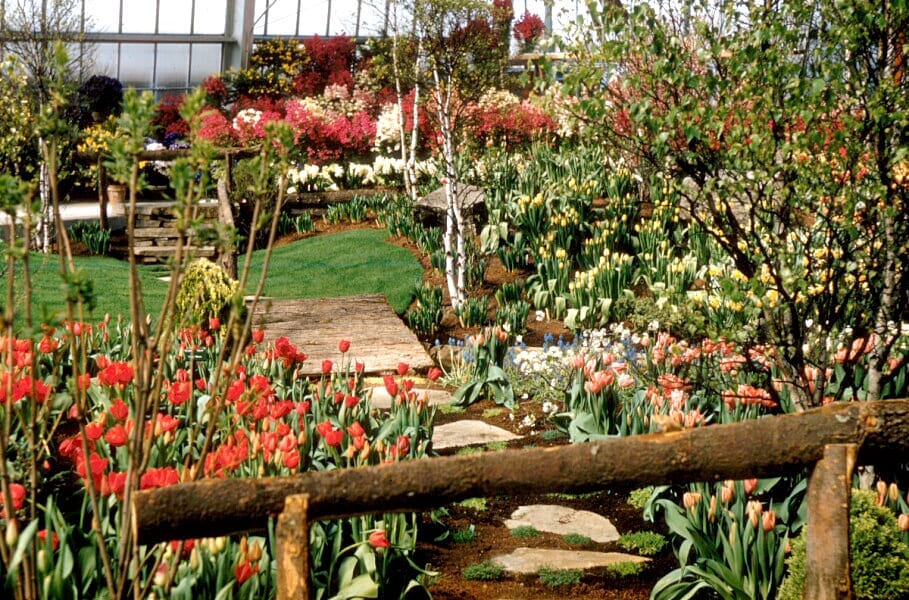The Montreal Botanical Garden: Showcase and custodian of an extraordinary plant heritage

Montreal is home to one of the four largest botanical gardens in the world. A remarkably diverse array of plants are on display in its many outdoor themed gardens and greenhouses. Since 70% of these plants are grown outdoors and are therefore adapted to winter in Quebec, they represent the horticultural heritage of southern Quebec. The Botanical Garden’s large collection reflects the passion the Western world has had for horticulture since the 19th century, a movement that resulted in the introduction of a wide variety of ornamental, medicinal and economic plants from around the world to Quebec and the rest of Canada. The Montreal Botanical Garden also has a collection of ancient, rare and threatened plants for preservation and research purposes. In addition, it produces new hybrids, such as Montreal echinacea, Montreal’s floral emblem created in honour of the city’s 375th anniversary in 2017.
To learn more…
Knowledge transmission
In addition to maintaining its hundreds of awe-inspiring landscaped areas, flowers, colours, exotic plants, trees and shrubs that few visitors could manage to take in in a single day, the Botanical Garden’s highly specialized employees are keen on transmitting their knowledge and passion to as many people as they can.
A team of skilled facilitators wander the gardens and answer questions. In the large Chinese, Japanese and First Nations gardens and the arboretum (in the Tree Pavilion), employees educate the public about these broad topics and organize activities to enhance the horticultural experience. In keeping with the vision of the Botanical Garden’s main founder, Brother Marie Victorin, who wanted to make science accessible to all people, especially children, several programs are offered for school-age children. These complementary activities focus on pumpkins (an Aboriginal heritage plant), trees and the urban ecosystem, and include horticultural day camps or the Youth Gardens, both of which allow young people between the ages of 8 and 15 to grow their own garden under the supervision of counsellors.
The Botanical Garden’s library, its website and the horticultural officers at the information desk are other resources to share knowledge. The École des métiers de l’horticulture de Montréal also sends trainees to the Montreal Botanical Garden, which was founded in 1932, to allow them to learn from the employees who look after the 22,000 taxa (different plants). A Biodiversity Centre, which has a permanent exhibit, also transmits knowledge.
Preserving and showcasing plant heritage
The Montreal Botanical Garden is part of a network of international horticultural institutions that share the same passion for preserving and showcasing the world’s plant heritage. Most of the Botanical Garden’s plants are now from outside Canada, since the organization is committed to preserving world biodiversity for future generations. The Botanical Garden is increasingly enhancing its collections with plants taken from their natural habitat, in accordance with strict rules aimed at protecting the world’s plants, which are threatened by development.
In addition to enhancing the beauty and originality of the gardens and greenhouses where visitors can admire thousands of plants from here and around the world, the collections maintained by some 50 specialized horticulturalists and several dozen gardeners guarantee the preservation of endangered and threatened species. Since the acquisition of the first plants in the 1930s, the Botanical Garden’s challenge has been to ensure the sustainability of its growing collections and to document them in order to enhance their value: Where do they come from? How are they to be cared for and reproduced? How should they be exhibited?
At the Montreal Botanical Garden, Quebec’s Aboriginal heritage can be viewed exclusively in the First Nations Garden and the Quebec Corner. Brother Marie Victorin, founder of the Botanical Garden and indefatigable herbalist, is responsible for the first major inventory of Quebec’s flora, La flore laurentienne, published for the first time in 1935. His herbarium has been preserved and can be consulted at the Institut de recherche en biologie végétale on site.
The power of plants
In addition to delighting and educating the public and preserving the plant heritage, the Montreal Botanical Garden also does research. Staff at the Institut de recherche en biologie végétale, which partners with the Montreal Botanical Garden and the Université de Montréal, focuses mainly on phytotechnology, an area in which it has special expertise. The Botanical Garden has been an expert in horticultural beauty for many years. Now it is also an expert in the utilitarian value of plants and their many psychological and environmental benefits. To further this research and raise public awareness of these new avenues of sustainable development, the Botanical Garden is gradually creating a Pathway to Phytotechnologies that will eventually include seven elements, including filtering marshes that will eliminate pollutants in the water, plants that will be used to control shoreline erosion, and a living plant wall that will help block out traffic noise. This focus will attract a new clientele, on top of the 850,000 people who visit the Montreal Botanical Garden each year.





